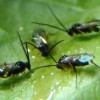Abstract
This species of Cotesia has been widely used as a model system in insect physiology. It has also been used to examine insect learning in host-parasitoid-plant interactions. It is an important natural enemy of the tobacco hornworm, a detrimental pest species that feeds on many plants in the Solanaceae (tobacco, pepper, tomato, etc.) family. This 5-page fact sheet was written by Christopher D. Crockett, Andrea Lucky, Oscar E. Liburd, and Karen M. Kester, and published by the UF Department of Entomology and Nematology, July 2014.
References
Adamo SA. 2005. Parasitic suppression of feeding in the tobacco hornworm, Manduca sexta: Parallels with feeding depression after an immune challenge. Archives of Insect Biochemistry and Physiology 60: 185-197. https://doi.org/10.1002/arch.20068
Beckage NE, Tan FF, Schleifer KW, Lane RD, Cherubin LL. 1994. Characterization and biological effects of Cotesia congregata polydnavirus on host larvae of the tobacco hornworm, Manduca sexta. Archives of Insect Biochemistry and Physiology 26: 165-195. https://doi.org/10.1002/arch.940260209
Bredlau JP, Mohajer YJ, Cameron TM, Kester KM, Fine ML. 2013. Characterization and Generation of Male Courtship Song in Cotesia congregata (Hymenoptera: Braconidae). PLoS ONE 8: e62051. https://doi.org/10.1371/journal.pone.0062051
de Buron I, Beckage NE. 1992. Characterization of polydnavirus (PDV) and virus-like filamentous particle (VLFP) in the braconid wasp Cotesia congregata (Hymenoptera: Braconidae). Journal of Invertebrate Pathology 59: 315-327. https://doi.org/10.1016/0022-2011(92)90139-U
Espagne E. 2004. Genome sequence of a polydnavirus: insights into symbiotic virus evolution. Science 306: 286-289. https://doi.org/10.1126/science.1103066
Fulton BB. 1940. The hornworm parasite, Apanteles congregatus (Say) and the hyperparasite, Hypopteromalus tabacum (Fitch). Annals of the Entomological Society of America 33: 231-244. https://doi.org/10.1093/aesa/33.2.231
Gilmore JU. 1938. Notes on Apanteles congregatus (Say) as a parasite of tobacco hornworms. Journal of Economic Entomology 31: 712-715. https://doi.org/10.1093/jee/31.6.712
Illinois Natural History Survey: Illinois Natural History Survey (accessed through GBIF data portal, http://data.gbif.org/datasets/resource/13517, 2014-05-08)
iNaturalist.org: iNaturalist research-grade observations (accessed through GBIF data portal, http://data.gbif.org/datasets/resource/14026, 2014-05-08).
Kester KM, Barbosa P. 1991. Post-emergence learning in the insect parasitoid, Cotesia congregata (Say) (Hymenoptera: Braconidae). Journal of Insect Behavior 4: 727-742. https://doi.org/10.1007/BF01052227
Kester KM, Barbosa P. 1994. Behavioral responses to host foodplants of two populations of the insect parasitoid Cotesia congregata (Say). Oecologia 99: 151-157. https://doi.org/10.1007/BF00317096
Krombein KV. 1979. Catalog of Hymenoptera in America north of Mexico. Smithsonian Institution Press, Washington D.C., USA.
Lawrence SE. 2010. Feeding behaviors of larval Manduca sexta parasitized by Cotesia congregata. (Order No. 1487815, State University of New York at Binghamton). ProQuest Dissertations and Theses, 56. Retrieved from http://search.proquest.com/docview/847404852?account id=10920. (847404852).
Lentz-Ronning AJ, Kester KM. 2012. Effect of sequential learning experiences on searching responses and sex ratio allocations of the gregarious insect parasitoid, Cotesia congregata (Say)(Hymenoptera: Braconidae). Journal of Insect Behavior 26: 165-175. https://doi.org/10.1007/s10905-012-9345-5
Mason WRM. 1981. The polyphyletic nature of Apanteles förster (Hymenoptera: Braconidae): a phylogeny and reclassification of Microgastrinae. Memoirs of the Entomological Society of Canada 115: 1-147. https://doi.org/10.4039/entm113115fv
Molina-Ochoa J, Carpenter JE, Heinrichs EA, Foster JE. 2003. Parasitoids and parasites of Spodoptera frugiperda (Lepidoptera: Noctuidae) in the Americas and Caribbean Basin: an inventory. Florida Entomologist 86: 254-289. https://doi.org/10.1653/0015-4040(2003)086[0254:PAPOSF]2.0.CO;2
Ratnasingham S, Hebert PDN. 2007. BOLD: The Barcode of Life Data System (www.barcodinglife.org). Molecular Ecology Notes 7, 355-364. (http://www.boldsystems.org/index.php/TaxBrowser_Taxonpage?taxid=106531) https://doi.org/10.1111/j.1471-8286.2007.01678.x
Sharkey MJ, Whitfield J, Seltmann K. 2005. Species home pages for economically important species parasitic wasps of the genus Cotesia (Hymenoptera: Braconidae). Both at http://www.uky.edu/~mjshar0/genera/Cotesia/congregata.html
Shaw MR, Huddleston T. 1991. Classification and biology of braconid wasps (Hymenoptera: Braconidae). Handbooks for the Identification of British Insects (ed. by W. R. Dolling and R. R. Askew), Vol. 7, pp. 1-126. Royal Entomological Society of London, London.
Thorpe KW, Barbosa P. 1986. Effects of consumption of high and low nicotine tobacco by Manduca sexta (Lepidoptera: Sphingidae) on survival of gregarious endoparasitoid Cotesia congregata (Hymenoptera: Braconidae). Journal of Chemical Ecology 12: 1329-1337. https://doi.org/10.1007/BF01012352
Turlings TCJ, Tumlinson JH, Lewis WJ. 1990. Exploitation of herbivore-induced plant odors by host-seeking parasitic wasps. Science 250: 1251-1253. https://doi.org/10.1126/science.250.4985.1251
Witting-Bissinger BE, Orr DB, Linker HM. 2008. Effects of floral resources on fitness of the parasitoids Trichogramma exiguum (Hymenoptera: Trichogrammatidae) and Cotesia congregata (Hymenoptera: Braconidae). Biological Control 47: 180-186. https://doi.org/10.1016/j.biocontrol.2008.07.013

